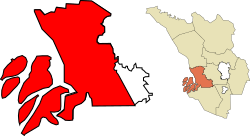Klang (city)
| Bandaraya Klang | ||
|---|---|---|
| Royal town | ||

The palace of the Sultan of Selangor in Klang
|
||
|
||
| Nickname(s): Klang | ||
| Motto: Perpaduan Sendi Kekuatan (Malay) "Strength Through Unity" |
||
 Location of area under MP Klang (red) within the Klang District (orange), and the state of Selangor (yellow). |
||
| Location of area under MP Klang (red) within the Klang District (orange), and the state of Selangor (yellow). | ||
| Coordinates: 3°02′N 101°27′E / 3.033°N 101.450°E | ||
| Country | Malaysia | |
| State | Selangor | |
| Granted Municipal Status |
1 January 1977 | |
| Government | ||
| • Administered by | Klang Municipal Council | |
| • Yang diPertua (President) |
Datuk Mohd Yazid Bidin | |
| Area | ||
| • Total | 573 km2 (202 sq mi) | |
| Population (2010) | ||
| • Total | 744,062 | |
| • Density | 1,298/km2 (3,360/sq mi) | |
| Time zone | MST (UTC+8) | |
| • Summer (DST) | Not observed (UTC) | |
| Website | mpklang |
|
Klang or Kelang, officially Royal Town of Klang (Malay: Bandar Diraja Klang), is a royal town and former capital of the state of Selangor, Malaysia. It is located within the Klang District. It was the civil capital of Selangor in an earlier era prior to the emergence of Kuala Lumpur and the current capital, Shah Alam. Port Klang, which is located in the Klang District, is the 13th busiest transshipment port and the 16th busiest container port in the world.
The Klang Municipal Council or MP Klang exercises jurisdiction for a majority of the Klang District while the Shah Alam City Council exercises some jurisdiction over the east of Klang District, north of Petaling District and the other parts of Selangor State including Shah Alam itself.
As of 2010, the Klang City has a total population of 240,016 (10,445 in the city centre), while the population of Klang District is 842,146, and the population of all towns managed by Klang Municipal Council is 744,062.
The royal town of Klang has been a site of human settlement since prehistoric times. Bronze Age drums, axes and other artefacts have been found in the vicinity of the town and within the town itself. A bronze bell dating from the 2nd century BC was found in Klang and is now in the British Museum.Iron age tools called "tulang mawas" ("ape bones") have also been found in Klang. Commanding the approaches to the tin rich Klang Valley, Klang has always been of key strategic importance. It was mentioned as a dependency of other states as early as the 11th century. Klang was also mentioned in the 14th century literary work Nagarakretagama dated to the Majapahit Empire, and the Klang River was already marked and named on the earliest maritime charts of Chinese Admiral Cheng Ho on his visits to Malacca from 1409 to 1433.
...
Wikipedia


